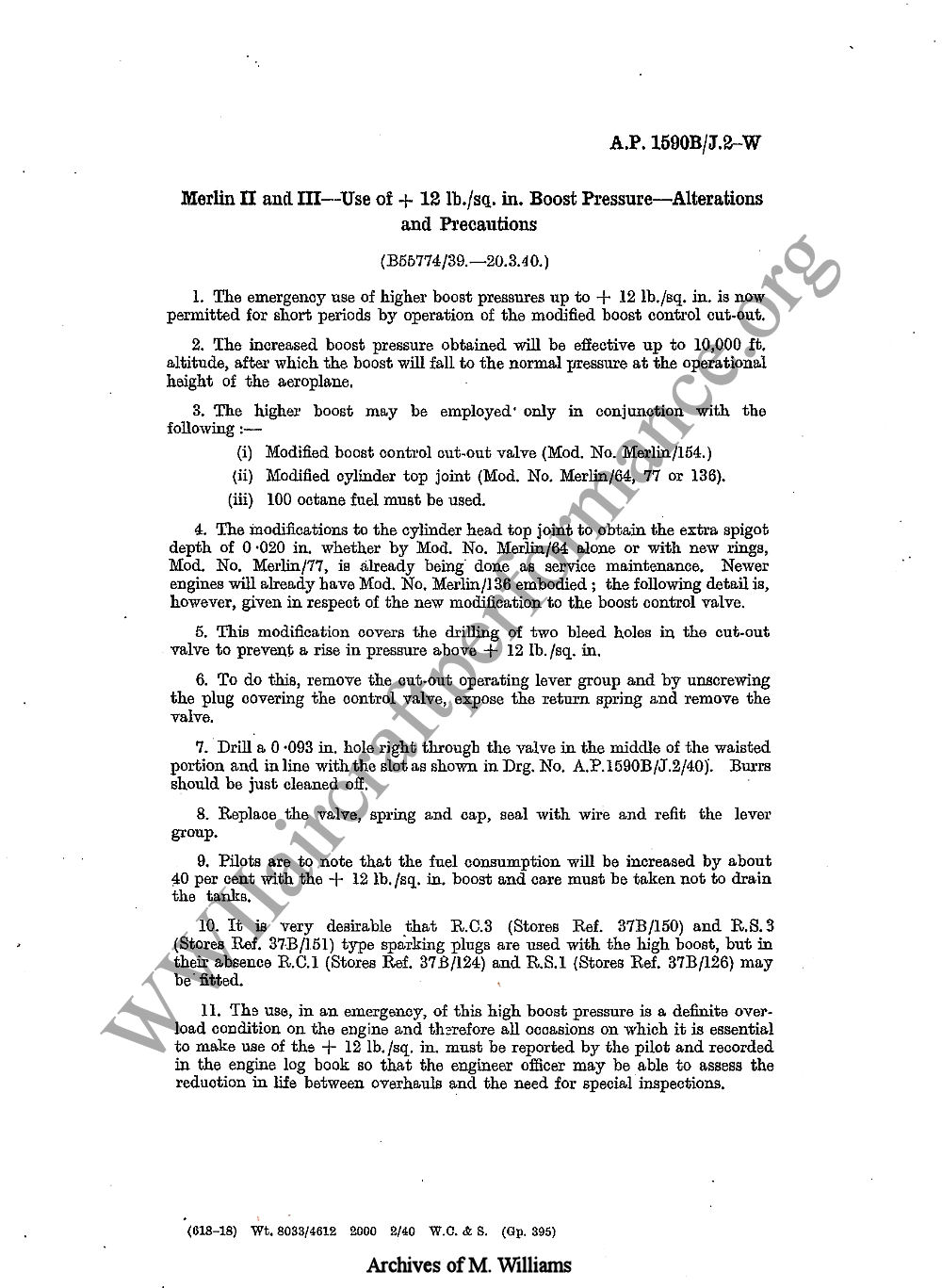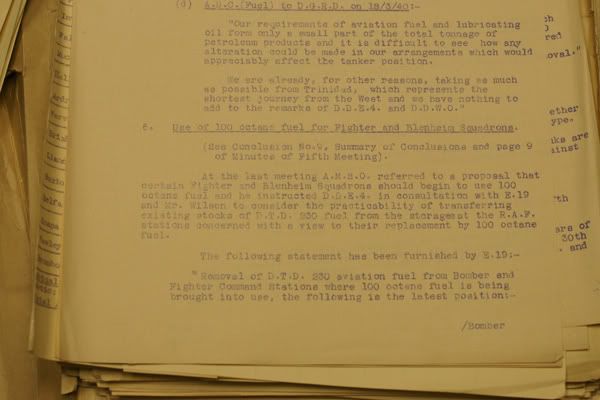
 |
|
|||||||
| FM/DM threads Everything about FM/DM in CoD |
 |
|
|
Thread Tools | Display Modes |
|
|
|
#1
|
|||
|
|||
|
because that was the only difference right?
|
|
#2
|
||||
|
||||
 These were the alterations made (dated March 20th 1940). After the alteration the only difference in actual operation was the modified boost cut-out control allowing the ability of the engine to be run on 100 octane fuel up to +12lbs. sq. in. The engine was still perfectly capable of being run on 87 octane fuel and indeed this would avoid the problem of lead fouling of the spark plugs if they had not been changed to the new ones. You will note the last paragraph. Mechanics were not likely to run the engine up to +12lbs on the ground. Its use significantly reduced engine life. Last edited by TheGrunch; 04-05-2011 at 08:59 AM. |
|
#3
|
|||
|
|||
|
Since the FTH for +12 was 10,000 feet or so, it would be pretty reckless not to ground test at +12 to ensure that Mod. No. Merlin/154 was embodied correctly given that it was a local mod; otherwise there would be no guarantee that +12 might not be exceeded, leading to rapid failure in flight.
Reverting to 87 octane would require that the 87 octane limits be observed; since operation of the cutout would now give +12 it would probably be wired shut; clearly in this condition the aeroplane would not be exactly combat ready. Having filled the tanks with 87 octane again, they would probably require cleaning when reverting to 100 octane to ensure that the fuel reaching the engine met the performance standard. Changing fuel is not quite so small an undertaking as many would imagine; aeroplanes are less forgiving than cars, and the consequences of engine failure are inevitably more severe. |
|
#4
|
||||
|
||||
|
Given that as far as I am aware the 100 octane fuel was mixed by mixing the iso-octane with existing 87 octane fuel I cannot imagine that a tiny remnant of 87 octane would be something to get distressed about, however I will admit that the possibility of Mod 154 being performed incorrectly might be something they would test, agreed. However the since local mod would be performed on existing engines that had already seen use I am unsure as to what this would mean in terms of the treatment of the engine immediately after the mod.
|
|
#5
|
|||
|
|||
|
Quote:
So 0 octane = 100% n-Heptane 50 octane = 50% n-Heptane + 50% iso-octane 100 octane = 100% iso-octane Fuels are evaluated by testing them on a variable compression ratio engine and then mixing a reference fuel to match their performance. Note that this scale cannot measure any fuel outside of the range 0-100 octane. There is quite a lot of casual incorrect use of the octane scale for values >100, but this is simply incorrect. A different scale (Performance number) is used to rate fuels superior to 100 octane; the performance number being the ratio of the power produced by the reference fuel running on the test engine without detonation to that produced by 100 octane running on the test engine. This naturally varies as a function of mixture strength, so for example modern 100 LL will give approximately 100/130 performance number (weak/rich), whilst late war purple fuel could give 115/145 Performance number. Care must be taken when comparing fuels to check exactly which rating scale is in use; the power output achievable from a fuel is not necessarily a linear function of its octane number, so you can't make a direct comparison between an octane number and a performance number. Additionally, there were several different test procedures in use which would produce different results from identical fuels (ie MON, RON etc). Production fuels were not made in a chemistry lab by mixing individual chemical isomers together; this would have been impractical. The Germans were somewhat closer to this approach with their use of Fischer-Tropsch derived synthetic oils, but even then they didn't go to the lengths of blending up their fuels isomer by isomer, because it just wouldn't be worth the effort. About the closest that anybody has ever come to this kind of "chemistry lab" approach was JP-7 for the SR-71, and that was phenomenally expensive stuff... Instead, production fuels were made by distillation of crude and the judicious use of additives such as TEL. AFAIK, 100 octane used a slightly different distillation range from 87, and there may have been some catalytic processing (eg cracking etc) to improve yields, but without making direct reference to a contemporary reference on the subject I couldn't be certain off the top of my head. However, I'm pretty certain that the main difference between 87 octane and 100 octane was the amount of TEL used. This would have been a variable, because different wells produce different crudes which will produce different products at the refinery, so the amount of TEL required to meet the 100 octane standard would have been varied from batch to batch. Even today, the specification therefore just includes an upper limit for TEL content. To get an idea of just how many chemicals are actually contained in real fuel, you can read the safety sheet. In any case, if you don't clean the tanks when swapping from 87 octane to 100 octane then you'll end up with a mixture which will have some undetermined intermediate octane rating. Running at +12 on this mixture is not the same as running at +12 on 100 octane, and might cause pre-ignition or detonation. It would therefore be advisable to flush the fuel system thoroughly with 100 octane before embarking on +12 running, and the obvious way to do that without taking the whole aeroplane & engine to bits would just be to ground run through say a tank full of 100 octane. Then you can be pretty certain that all the 87 octane is out of the system and it should be safe to start testing at +12. You would then probably conduct a few minutes of running at high boost to ensure that the boost control cutout was really delivering +12. |
|
#6
|
||||
|
||||
|
Thanks for the info Viper...possibly a bit of a Chinese whispers effect going on there as to how the fuel was mixed, then.
|
|
#7
|
|||
|
|||
|
Quote:
Apologies for possibly restarting an old debate but there would be no need for tanks to be refilled with 87 octane as all RAF front line squadrons were fully equipped with 100 Octane. 87 Octane was used in OCU units that were equipped with Spitfires and Hurricanes but not front line units. I am the poster who disagreed with Kurfurst in the WW2 Aircraft forum and am able to support any statement or figure that was made by myself in that forum on this subject with published information and or original documentation. If you have incorporated any of Kurfursts theories into your work then I am afraid that you have been seriously misled. You will find that Kurfurst will not be able to support his statements. If you have any questions or doubts then please do not hesitate to raise them and I will be able to adress them in open discussion. Last edited by Glider; 06-16-2011 at 01:59 PM. |
|
#8
|
|||
|
|||
|
Quote:
I've asked you several times to do so. You were not able to. During the previous discussion, you have supplied a paper which directly contradicted your past and present claims, stating that 100 octane was to be supplied to "certain Fighter and Blenheim Squadrons": 
__________________
Il-2Bugtracker: Feature #200: Missing 100 octane subtypes of Bf 109E and Bf 110C http://www.il2bugtracker.com/issues/200 Il-2Bugtracker: Bug #415: Spitfire Mk I, Ia, and Mk II: Stability and Control http://www.il2bugtracker.com/issues/415 Kurfürst - Your resource site on Bf 109 performance! http://kurfurst.org 
Last edited by Kurfürst; 06-16-2011 at 02:24 PM. |
|
#9
|
|||
|
|||
|
Kurfurst
While I wait for the other questions can you tell me what certain means such as how many and of what type? You have encouraged some big assumptions in this thread so how many is certain and how did you come to that assumption? I will support my statement that you know, as I have always done before, but I want to know how you came to these figures. |
|
#10
|
|||
|
|||
|
Quote:
I am pretty sure though its meaning is in stark contrast with all. Quote:
The document you posted and which directly contradicts your thesis speaks of no uncertain terms of certain Fighter and Blenheim Squadrons. That's not an assumptopn - it's a fact. Quote:
I've asked you several times to do so. You were not able to. I've asked again in this thread. You've evaded the question. So I ask again: Can you present a single document stating so..? The reason I have to ask you for the second time and about the tenth time since we have this discussion is because you were completely unable to support your statement.
__________________
Il-2Bugtracker: Feature #200: Missing 100 octane subtypes of Bf 109E and Bf 110C http://www.il2bugtracker.com/issues/200 Il-2Bugtracker: Bug #415: Spitfire Mk I, Ia, and Mk II: Stability and Control http://www.il2bugtracker.com/issues/415 Kurfürst - Your resource site on Bf 109 performance! http://kurfurst.org 
Last edited by Kurfürst; 06-16-2011 at 02:59 PM. |
 |
| Thread Tools | |
| Display Modes | |
|
|